Relationship Communication Skills: Building Stronger Bonds
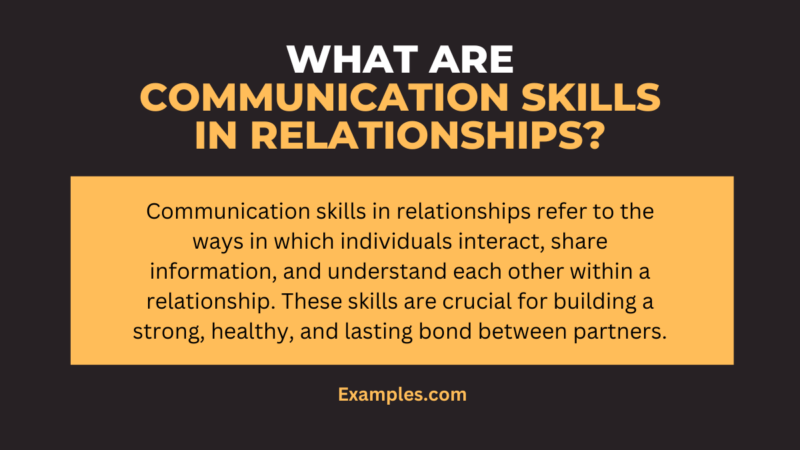
Relationship communication skills set the stage for this enthralling narrative, offering readers a glimpse into a story rich in detail and brimming with originality from the outset. It’s a journey that delves into the intricacies of how we connect, understand, and navigate the complexities of human relationships.
This exploration will unveil the power of effective communication, highlighting how it serves as the cornerstone for fostering meaningful connections and navigating the challenges that inevitably arise in any relationship.
The Artikel explores various facets of relationship communication, from active listening and empathy to assertive communication and conflict resolution. It also delves into the nuances of nonverbal communication, the importance of open and honest dialogue, and the role of emotional intelligence in strengthening relationships.
By understanding and applying these principles, individuals can cultivate healthier, more fulfilling, and enduring connections with their loved ones.
Understanding Relationship Communication Skills
Effective communication is the cornerstone of any successful relationship. The bridge connects individuals, fostering understanding, intimacy, and a sense of shared purpose. Strong communication skills are not merely about exchanging words; they involve actively listening, expressing oneself clearly, and navigating conflicts constructively.
Importance of Effective Communication in Relationships
Effective communication is essential for healthy and fulfilling relationships. It enables individuals to:
- Build Trust and Intimacy: Open and honest communication fosters trust and intimacy, allowing partners to feel safe and understood.
- Resolve Conflicts: Healthy communication skills empower couples to navigate disagreements constructively, leading to mutually acceptable solutions.
- Strengthen Bonds: Sharing thoughts, feelings, and experiences strengthens the emotional connection between partners, creating a sense of shared history and purpose.
- Improve Overall Relationship Satisfaction: Effective communication contributes to a more fulfilling and satisfying relationship by reducing misunderstandings and fostering emotional closeness.
Key Elements of Strong Relationship Communication Skills
Several key elements contribute to strong relationship communication skills. These include:
- Active Listening: This involves paying full attention to your partner, not just hearing their words but also understanding their emotions and perspectives. It requires focusing on what they are saying, asking clarifying questions, and demonstrating empathy.
- Clear and Concise Expression: Expressing your thoughts and feelings clearly and concisely helps avoid misunderstandings. This involves using “I” statements to convey your perspective without blaming your partner.
- Empathy and Understanding: Empathy involves understanding and acknowledging your partner’s feelings, even if you don’t agree with them. It requires putting yourself in their shoes and trying to see things from their perspective.
- Non-Verbal Communication: Non-verbal cues, such as body language, tone of voice, and facial expressions, can significantly impact communication. Being aware of your non-verbal signals and interpreting your partner’s can enhance understanding.
- Conflict Resolution Skills: Disagreements are inevitable in any relationship. Effective communication involves learning to resolve conflicts constructively, through compromise, negotiation, and finding mutually acceptable solutions.
Examples of Successful Communication Strategies in Relationships
Several communication strategies can enhance relationships. Here are a few examples:
- Regular Check-Ins: Schedule dedicated time to connect with your partner, and discuss your thoughts, feelings, and experiences. This fosters open communication and prevents issues from festering.
- “I” Statements: Instead of blaming your partner, use “I” statements to express your feelings and needs. For example, “I feel hurt when you don’t respond to my texts” is more effective than “You never respond to my texts.”
- Active Listening and Validation: When your partner shares their feelings, listen attentively, acknowledge their emotions, and show empathy. This creates a safe space for open communication.
- Compromise and Negotiation: In disagreements, aim to find solutions that meet both your needs. This involves being willing to compromise and negotiate, finding common ground, and finding mutually acceptable solutions.
- Seek Professional Help: If communication challenges persist, seeking professional guidance from a therapist or counselor can provide valuable tools and strategies to improve communication and strengthen the relationship.
Active Listening and Empathy
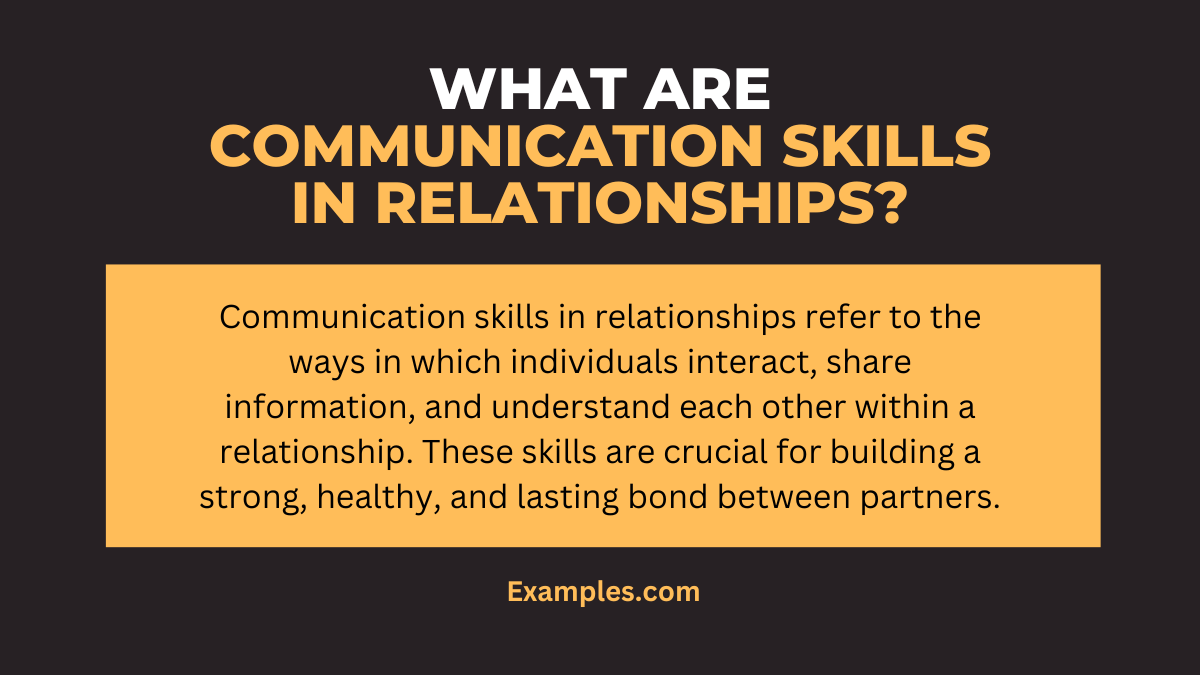
Active listening and empathy are essential communication skills that foster understanding, strengthen relationships, and create a positive environment for interaction. When we actively listen and demonstrate empathy, we show the other person that we care about their thoughts and feelings, creating a foundation for meaningful connection and mutual respect.
The Role of Active Listening in Building Strong Relationships
Active listening is more than just hearing the words someone says. It involves paying full attention to the speaker, both verbally and nonverbally, and demonstrating understanding and engagement. This process helps build trust and strengthens relationships by:
- Enhancing Understanding: Active listening allows us to grasp the speaker’s message, including their emotions and underlying meaning, leading to deeper comprehension and fewer misunderstandings.
- Building Trust and Connection: When people feel heard and understood, they feel valued and respected. This fosters trust and creates a stronger connection between individuals.
- Improving Communication: By actively listening, we can clarify doubts, ask relevant questions, and provide constructive feedback, leading to more effective communication and problem-solving.
- Reducing Conflict: When individuals feel heard and understood, it reduces the likelihood of misunderstandings and conflict. Active listening can help diffuse tension and promote peaceful resolution.
Active Listening Techniques
Active listening involves employing various techniques to demonstrate engagement and understanding. These techniques include:
- Nonverbal Cues: Maintaining eye contact, nodding your head, and using appropriate facial expressions signal your attentiveness and interest in the speaker’s message.
- Verbal Cues: Using phrases like “I understand,” “Tell me more,” or “That’s interesting” encourages the speaker to continue and demonstrates your engagement.
- Paraphrasing and Summarizing: Restating the speaker’s message in your own words helps confirm your understanding and ensures that you are on the same page.
- Asking Clarifying Questions: Asking questions to seek further information or clarification demonstrates your interest and ensures that you are comprehending the speaker’s message accurately.
- Avoiding Interruptions: Allow the speaker to finish their thoughts without interrupting. This shows respect and allows for a complete and clear message.
Practicing Empathy in Communication
Empathy is the ability to understand and share the feelings of another person. In communication, empathy involves recognizing and acknowledging the speaker’s emotions, even if you don’t necessarily agree with them.
- Validate Their Feelings: Let the speaker know that you understand and acknowledge their emotions, even if you don’t share them. Phrases like “I can see why you’re feeling that way” or “It sounds like you’re upset” can be helpful.
- Avoid Judgment: When practicing empathy, it’s crucial to avoid judging the speaker’s feelings or opinions. Focus on understanding their perspective and showing compassion.
- Consider Their Perspective: Try to step into the speaker’s shoes and understand their situation from their point of view. This helps you to see the world through their eyes and connect with their emotions.
- Use “I” Statements: When expressing your feelings, use “I” statements to avoid blaming or accusing the speaker. For example, instead of saying “You made me feel bad,” try “I felt hurt when you said that.”
Assertive Communication
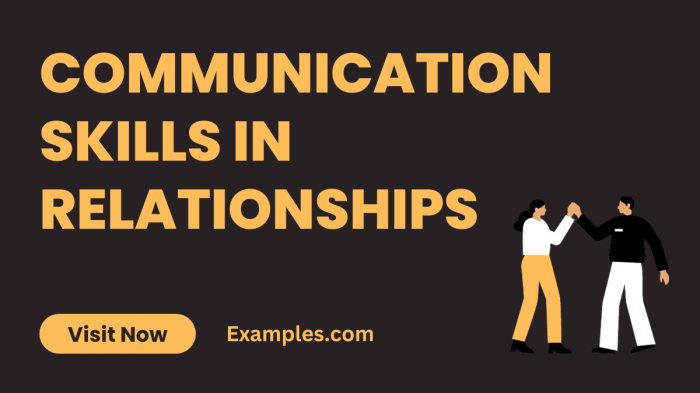
Assertive communication is a vital skill in any relationship, as it allows individuals to express their needs and opinions clearly and respectfully while also acknowledging the needs and opinions of others. This style of communication fosters healthy boundaries, mutual respect, and a greater sense of understanding and connection within relationships.
Importance of Assertive Communication in Relationships
Assertive communication is crucial for building and maintaining healthy relationships. It helps to:
- Improve Communication and Understanding: Assertive communication encourages open and honest dialogue, leading to a deeper understanding of each other’s perspectives and needs.
- Resolve Conflicts Effectively: By expressing concerns and needs directly, assertive communication facilitates constructive conflict resolution and prevents misunderstandings from escalating.
- Strengthen Relationships: When individuals feel heard and respected, it fosters a sense of trust and intimacy, strengthening the bond between them.
- Promote Self-Respect and Confidence: Assertive communication empowers individuals to stand up for themselves and their values, boosting self-esteem and confidence.
- Reduce Stress and Anxiety: By expressing needs and setting boundaries, assertive communication helps reduce stress and anxiety associated with feeling unheard or taken advantage of.
Assertive Communication Techniques
Assertive communication involves using “I” statements to express feelings and needs clearly and respectfully. Here are some techniques:
- “I” Statements: Instead of blaming or accusing, use “I” statements to express your feelings and needs. For example, instead of saying, “You always make me feel bad,” say, “I feel hurt when you say that.”
- Active Listening: Pay attention to the other person’s perspective and acknowledge their feelings. Show that you are listening and understanding their point of view.
- Setting Boundaries: Communicate your limits and expectations. For example, “I am happy to help, but I need to finish this task first.”
- Using Assertive Body Language: Maintain eye contact, speak in a calm and clear voice, and use appropriate gestures to convey confidence and respect.
- Negotiation and Compromise: Be willing to negotiate and find solutions that work for both parties involved. This demonstrates a willingness to collaborate and find common ground.
Comparison of Communication Styles
It’s important to understand how assertive communication differs from other styles:
| Communication Style | Characteristics | Example |
|---|---|---|
| Passive | Avoids expressing needs and opinions, often leading to resentment and frustration. | “It’s okay, I don’t mind doing it.” (When they do mind) |
| Aggressive | Dominates the conversation, disregards others’ feelings, and often leads to conflict. | “You’re always so lazy! Why can’t you ever help out?” |
| Assertive | Expresses needs and opinions respectfully, while acknowledging the needs of others. | “I understand you’re busy, but I would appreciate it if you could help me with this.” |
Conflict Resolution and Negotiation
Conflict is an inevitable part of any relationship, whether it be romantic, familial, or professional. Healthy conflict resolution is crucial for maintaining strong and fulfilling relationships. Learning effective strategies for navigating disagreements and finding mutually agreeable solutions is essential for fostering understanding, respect, and lasting connection.
Importance of Healthy Conflict Resolution
Healthy conflict resolution is vital for fostering positive relationships. It allows couples to address issues constructively, preventing them from escalating into resentment, anger, and further conflict. When conflicts are resolved effectively, couples can build trust, strengthen their bond, and create a more harmonious environment.
Effective Strategies for Resolving Conflicts Constructively
Resolving conflicts constructively requires a combination of communication skills, empathy, and a willingness to compromise. Here are some effective strategies:
- Choose the Right Time and Place: Avoid confronting sensitive topics when either person is tired, stressed, or distracted. Find a calm and private setting where you can talk openly without interruptions.
- Active Listening: Pay close attention to your partner’s perspective and emotions. Use verbal and nonverbal cues to demonstrate that you are truly listening and understanding their point of view.
- Empathy: Try to see the situation from your partner’s perspective, even if you don’t agree with their viewpoint. Empathy fosters understanding and reduces defensiveness.
- Focus on the Problem, Not the Person: Avoid attacking or blaming your partner. Instead, focus on the specific issue at hand and work together to find solutions.
- Use “I” Statements: Take responsibility for your feelings and opinions. For example, instead of saying “You always make me feel bad,” try “I feel hurt when you say that.” This helps to avoid accusations and defensiveness.
- Take Breaks When Needed: If the conversation becomes heated, take a break to cool down and regain perspective. Agree to revisit the issue later when both of you are calmer.
- Compromise and Find Solutions: Be willing to compromise and find solutions that work for both of you. This may involve finding a middle ground or making concessions.
Negotiation in Reaching Mutually Agreeable Solutions
Negotiation is an essential part of conflict resolution. It involves finding common ground and reaching a solution that satisfies both parties. Effective negotiation requires:
- Open Communication: Clearly express your needs and expectations while actively listening to your partner’s perspective.
- Identifying Shared Goals: Focus on finding areas of agreement and shared goals. This creates a foundation for collaboration.
- Generating Options: Brainstorm a variety of solutions that address both parties’ needs. Be creative and open to new ideas.
- Evaluating Options: Consider the pros and cons of each option, weighing the potential benefits and drawbacks.
- Reaching Agreement: Work towards a solution that is mutually acceptable and addresses the core issues of the conflict.
Nonverbal Communication: Relationship Communication Skills
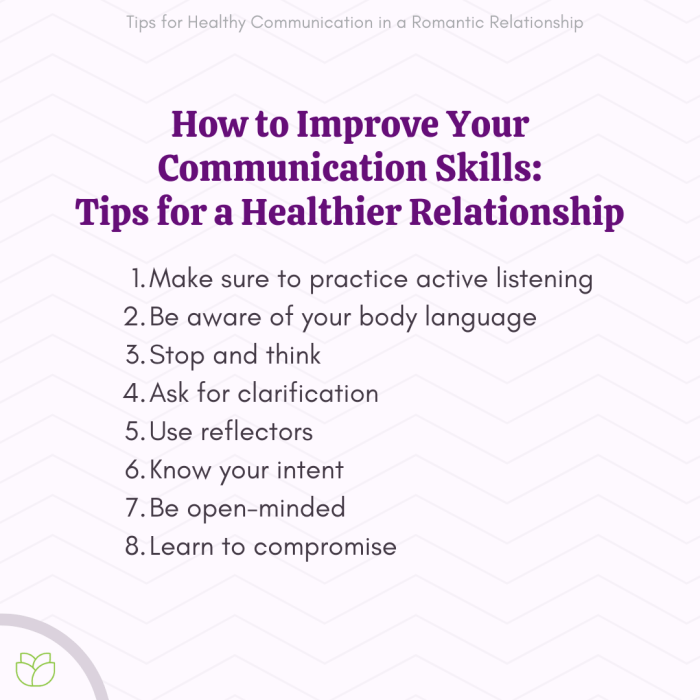
Nonverbal communication is an essential aspect of relationships, conveying emotions, attitudes, and intentions that words alone may not fully express. It encompasses a range of cues, including body language, tone of voice, and facial expressions, all playing a significant role in shaping our understanding and interpretation of messages.
Body Language
Body language refers to the physical movements, postures, and gestures we use to communicate. It can be conscious or unconscious, and it often reveals our true feelings and intentions even when we try to hide them.
- Posture: Our posture can communicate confidence, insecurity, openness, or defensiveness. For instance, a slumped posture might suggest disinterest or lack of confidence, while an upright posture can convey confidence and attentiveness.
- Gestures: Hand gestures can emphasize points, express emotions, or even replace words entirely. For example, a thumbs-up gesture signifies approval, while a clenched fist might indicate anger or frustration.
- Eye Contact: Eye contact is crucial for establishing a connection and conveying sincerity. Direct eye contact shows interest and engagement while avoiding eye contact can suggest disinterest or dishonesty.
- Proximity: The physical distance we maintain from others can communicate intimacy, respect, or discomfort. Standing too close can make others feel uncomfortable while maintaining a comfortable distance shows respect and consideration.
Tone of Voice
The tone of voice, also known as vocal inflection, plays a significant role in conveying emotions and intentions. It can add layers of meaning to spoken words, influencing how our messages are interpreted.
- Pitch: The pitch of our voice can convey excitement, nervousness, or boredom. A high-pitched voice might suggest excitement or nervousness, while a low-pitched voice can sound more authoritative or relaxed.
- Volume: The volume of our voice can indicate intensity or confidence. Speaking loudly can convey enthusiasm or dominance while speaking softly might suggest humility or insecurity.
- Speed: The speed at which we speak can influence the perceived pace of our communication. Speaking quickly can suggest urgency or nervousness while speaking slowly might convey calmness or thoughtfulness.
- Pauses: Pauses in our speech can create emphasis, allow for reflection, or indicate hesitation. Strategic pauses can enhance the impact of our messages, while frequent pauses might suggest uncertainty or nervousness.
Facial Expressions
Facial expressions are one of the most powerful forms of nonverbal communication, instantly conveying emotions and intentions. They are often instinctive and difficult to control, making them a reliable indicator of our true feelings.
- Smiles: Smiles are generally associated with happiness, friendliness, and approval. However, different types of smiles can convey different emotions, such as a genuine smile versus a forced smile.
- Frowns: Frowns are typically associated with sadness, anger, or disapproval. They can signal displeasure, disagreement, or confusion.
- Eyebrow Movements: Eyebrow movements can convey surprise, disbelief, or concern. Raising eyebrows can indicate surprise or disbelief, while furrowing eyebrows might suggest anger or worry.
Maintaining Open and Honest Communication
Open and honest communication is the cornerstone of any healthy relationship. It fosters trust, understanding, and a sense of security between partners. When you communicate openly and honestly, you create a foundation for vulnerability, emotional intimacy, and a deeper connection.
Creating a Safe and Supportive Environment for Sharing Thoughts and Feelings
Creating a safe and supportive environment is crucial for open and honest communication. When both partners feel comfortable expressing their thoughts and feelings without fear of judgment or retaliation, it allows for deeper understanding and empathy. Here are some tips to create such an environment:
- Active Listening: Pay undivided attention to your partner, showing genuine interest in what they have to say. This involves making eye contact, nodding, and asking clarifying questions. Active listening demonstrates respect and encourages your partner to open up.
- Empathy: Try to understand your partner’s perspective, even if you don’t agree with it. Put yourself in their shoes and try to see things from their point of view. Empathy fosters understanding and reduces defensiveness.
- Non-Judgmental Attitude: Avoid interrupting or dismissing your partner’s feelings. Let them express themselves fully without feeling judged or criticized. This creates a safe space for vulnerability.
- Respectful Communication: Use “I” statements to express your feelings and needs without blaming or accusing your partner. For example, instead of saying “You always make me feel ignored,” try “I feel ignored when I don’t get a response to my messages.” This promotes a more constructive dialogue.
- Time and Space: Allow your partner the time and space they need to process their thoughts and feelings. Don’t pressure them to share everything immediately. Give them the freedom to open up at their own pace.
Handling Difficult Conversations Effectively
Difficult conversations are inevitable in any relationship. However, by approaching them with intention and respect, you can navigate them effectively and strengthen your bond. Here are some tips:
- Choose the Right Time and Place: Find a time when both partners are calm and relaxed. Avoid bringing up sensitive topics when you are stressed, tired, or distracted. Choose a private and comfortable setting where you can talk freely.
- Focus on the Issue: Stick to the topic at hand and avoid bringing up past grievances or unrelated issues. This keeps the conversation focused and productive.
- Use “I” Statements: Express your feelings and needs without blaming or accusing your partner. This helps to avoid defensiveness and encourages a more constructive dialogue.
- Listen Actively: Pay attention to your partner’s perspective and try to understand their point of view. Ask clarifying questions to ensure you understand what they are saying.
- Find Common Ground: Look for areas of agreement and focus on finding solutions that work for both partners. This fosters a sense of collaboration and strengthens the relationship.
- Take Breaks if Needed: If the conversation becomes heated, take a break to calm down and collect your thoughts. Resume the conversation when you are both ready to listen and communicate respectfully.
Building Emotional Intelligence
Emotional intelligence, also known as EQ, is the ability to understand and manage your own emotions, as well as recognize and respond to the emotions of others. It plays a crucial role in relationship communication, fostering deeper connections, resolving conflicts effectively, and creating a harmonious environment.
Identifying and Managing Your Own Emotions
Recognizing your emotions is the first step toward managing them effectively. It involves paying attention to your physical and mental sensations, such as your heart rate, breathing, and thoughts, to identify the emotions you are experiencing. Once you understand your emotions, you can begin to manage them by employing strategies like:
- Deep Breathing: Taking slow, deep breaths can help calm your nervous system and reduce stress.
- Mindfulness Meditation: Practicing mindfulness involves focusing on the present moment, and observing your thoughts and feelings without judgment. This can help you gain a greater awareness of your emotional state.
- Cognitive Reframing: This technique involves challenging negative thoughts and replacing them with more positive and realistic ones.
Understanding and Responding to the Emotions of Others
Empathy is the foundation of understanding and responding to the emotions of others. It involves actively listening to their words and observing their nonverbal cues to gain insight into their feelings. You can enhance your empathy skills by:
- Active Listening: Paying full attention to the speaker, asking clarifying questions, and reflecting on what you hear demonstrates your genuine interest and understanding.
- Nonverbal Communication: Observing body language, facial expressions, and tone of voice can provide valuable clues about someone’s emotional state.
- Perspective Taking: Trying to see the situation from the other person’s point of view can help you understand their feelings and motivations.
Communication Challenges and Solutions
Effective communication is crucial for a healthy and fulfilling relationship. However, various challenges can hinder open and honest dialogue, leading to misunderstandings, conflicts, and emotional distance. This section will explore common communication challenges in relationships, discuss the impact of cultural differences on communication styles, and provide solutions for overcoming these barriers.
Common Communication Challenges in Relationships
Communication challenges are common in relationships, often stemming from differences in communication styles, personality traits, or unresolved conflicts. These challenges can manifest in various ways, creating obstacles to effective communication.
- Lack of Active Listening: When partners fail to actively listen to each other, they may miss important information, leading to misunderstandings and frustration. This can occur when one partner is preoccupied with their thoughts, interrupting frequently, or not paying attention to nonverbal cues.
- Defensive Communication: Defensive communication occurs when individuals feel attacked or threatened, leading to a cycle of blame and resentment. This can manifest in responses like arguing, getting defensive, or shutting down completely, hindering open and honest dialogue.
- Negative Communication Patterns: Certain communication patterns can become detrimental to a relationship, such as criticism, contempt, defensiveness, and stonewalling. These patterns can erode trust, create distance, and lead to resentment.
- Unresolved Conflicts: Conflicts are inevitable in any relationship, but failing to resolve them effectively can lead to ongoing tension, resentment, and damage to the relationship. Unresolved conflicts can also create a pattern of avoidance, preventing partners from addressing underlying issues.
Impact of Cultural Differences on Communication Styles
Cultural differences can significantly impact communication styles, leading to misunderstandings and difficulties in establishing effective communication. Cultural norms, values, and beliefs shape how individuals communicate, including verbal and nonverbal cues.
- Direct vs. Indirect Communication: Some cultures value direct communication, where individuals express their thoughts and feelings explicitly, while others favor indirect communication, relying on nonverbal cues and subtle hints.
- Individualistic vs. Collectivistic Cultures: Individualistic cultures emphasize personal goals and self-expression, while collectivistic cultures prioritize group harmony and social obligations. This can influence communication styles, with individuals from collectivistic cultures often valuing politeness and avoiding conflict.
- Nonverbal Communication: Nonverbal cues, such as gestures, facial expressions, and body language, can vary significantly across cultures. Misinterpretations of nonverbal cues can lead to misunderstandings and strained communication.
Solutions for Overcoming Communication Barriers
Overcoming communication barriers requires a conscious effort from both partners, a willingness to understand each other’s perspectives, and a commitment to improving communication skills.
- Practice Active Listening: Active listening involves paying full attention to your partner, focusing on their words and nonverbal cues, and reflecting on their message to ensure understanding. This can help prevent misunderstandings and build empathy.
- Use “I” Statements: “I” statements express your feelings and needs without blaming or accusing your partner. For example, instead of saying, “You always forget to take out the trash,” try “I feel frustrated when the trash isn’t taken out.” This helps promote open and honest communication.
- Seek to Understand, Not to Win: When discussing disagreements, focus on understanding your partner’s perspective, even if you don’t agree with it. This can help break down defensive barriers and find common ground.
- Practice Forgiveness and Compromise: Forgiveness allows you to let go of past hurts and move forward in the relationship. Compromise involves finding solutions that meet both partners’ needs, demonstrating a willingness to collaborate and find common ground.
- Seek Professional Help: If communication challenges persist despite efforts to improve, seeking professional help from a therapist or counselor can provide valuable insights and guidance.
Communication in Different Relationship Stages
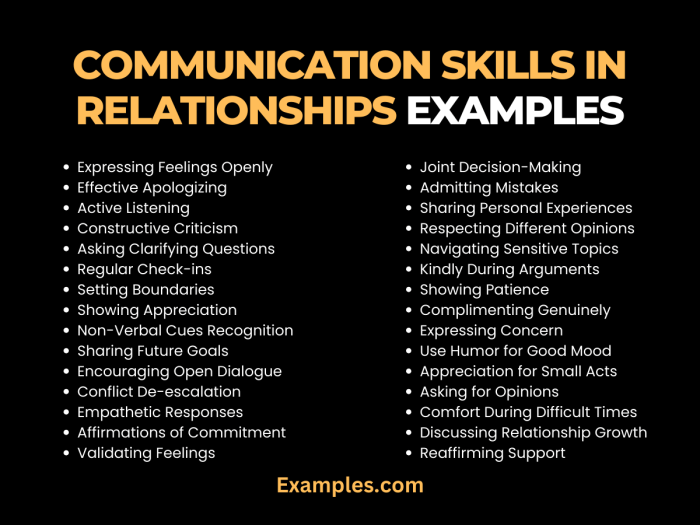
Relationships evolve, and so does the way we communicate within them. Understanding how communication patterns shift across different relationship stages can foster stronger connections and navigate challenges effectively.
Communication Patterns in Different Relationship Stages, Relationship Communication Skills
Communication patterns in relationships are dynamic and change with each stage. Here’s a look at communication trends in some common stages:
- Dating: During the initial dating phase, communication is often characterized by excitement, exploration, and a focus on shared interests. Conversations tend to be lighthearted, filled with questions about each other’s backgrounds, goals, and aspirations. This stage is crucial for building initial attraction and establishing a foundation for understanding.
- Early Relationship: As relationships progress, communication shifts towards deeper connection and intimacy. Couples may start sharing more personal information, expressing vulnerability, and engaging in more meaningful conversations. This stage is about building trust and emotional intimacy.
- Marriage: Communication in marriage often becomes more practical and focused on shared responsibilities, decision-making, and navigating daily life together. It’s essential to develop clear communication channels for handling household tasks, finances, and personal needs.
- Parenthood: The arrival of children introduces new dynamics and challenges to communication. Couples need to adjust their communication to accommodate the demands of parenting, including shared responsibilities, discipline, and navigating the emotional needs of their children.
Communication Needs Evolve Over Time
Communication needs to evolve throughout a relationship’s lifespan. Here are some key shifts:
- Increased Vulnerability: As trust deepens, couples become more comfortable sharing their vulnerabilities and emotional needs.
- Enhanced Conflict Resolution: With greater understanding, couples develop more effective strategies for resolving conflicts.
- Adapting to Change: Relationships undergo constant change, requiring couples to adapt their communication styles to address new challenges and growth opportunities.
Strategies for Adapting Communication Styles
Adjusting communication styles to different relationship stages is crucial for maintaining healthy connections. Consider these strategies:
- Open and Honest Dialogue: Regularly discuss your communication needs and how you can best support each other.
- Active Listening: Practice active listening to ensure you fully understand your partner’s perspective.
- Empathy and Validation: Show empathy and validate your partner’s feelings, even if you don’t agree with them.
- Conflict Resolution Skills: Employ effective conflict resolution strategies to address disagreements constructively.
- Flexibility and Adaptability: Be willing to adjust your communication style as the relationship evolves.
Wrap-Up
The journey into the world of relationship communication skills reveals a profound truth: communication is not just about exchanging words; it’s about building bridges of understanding, empathy, and respect. It’s about creating a safe space for vulnerability, fostering trust, and navigating the complexities of human interaction with grace and compassion.
By embracing these skills, individuals can transform their relationships, creating a foundation for deeper connection, lasting happiness, and a sense of shared purpose.
Comments are closed.